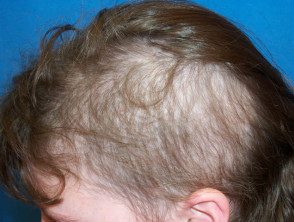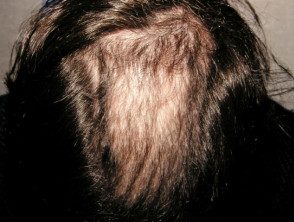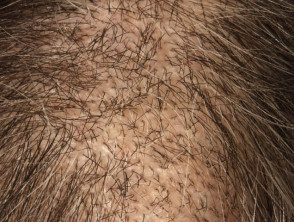What is trichotillomania?
Trichotillomania is a disorder characterized by an irresistible urge to remove or pull one's own hair, which results in alopecia (Hair loss). Trichotillomania is also called trichotylosis or hair pulling disorder.
Who gets trichotillomania?
Trichotillomania is estimated to affect up to 4% in the general population. It can affect men and women of any age, but it is more common in children than in adults. The onset peak generally occurs in the preschool years and also in early adolescence, usually around the time of puberty.
In boys, trichotillomania affects boys and girls equally, but with increasing age, it is seen more frequently in women. It is not clear if this is because women are more likely to seek treatment. Men can also disguise pulling hair as male pattern baldness and shaving.
What causes trichotillomania?
The exact cause of trichotillomania remains largely unknown. Note:
- There is a possible genetic tendency to trichotillomania.
- Trichotillomania often arises in individuals with haunting–compulsive disorder.
- It can develop as a coping mechanism triggered by stress or anxiety.
- It is commonly associated with other body-centered ones. repetitive behaviors, such as nail biting (onychophagy), scratching the skin, acne excoriation, lip biting, and cheek chewing.
- Neurological factors may be involved.
What are the clinical characteristics of trichotillomania?
The most common place to pull hair is on the scalp. The hairs can also be extracted from the eyebrows, eyelashes, trunk, arms, legs and pubic area.
- The places where the hair is pulled can change over time.
- Some people with trichotillomania pull hairs that they perceive to be different in length and texture from other hairs.
- The hair puller may or may not be aware of the habit. It can occur when the individual is engaged in other activities such as watching television, reading, studying and talking on the phone. It can also occur deliberately in association with compulsive impulses and anxiety that are relieved by pulling hair. Many people display both types of hair pulling behavior.
- Pulling hair can be pleasant and is generally not described as painful.
Hair loss patterns range from slight thinning or unnoticeable areas of hair loss to completely bald areas.
- Examination of the scalp may reveal patches of alopecia that are irregular in shape.
- They can be felt with stubble, with hairs of different lengths.
- Children tend to pull hairs that are easy to reach and are on the same side as their dominant hand. These are generally the frontotemporal areas (areas behind the forehead and ears) and the vertex (top of the head).
- Eyelashes and eyebrows may also be broken or missing.
- Scratches, bruises and erythema pick up can also be seen.
- Repeated depilation damages the follicles and can cause irreversible scars
Trichotillomania

Trichotillomania

trichotillomania 03

See more trichotillomania images ...
What are the complications of trichotillomania?
Trichobezoar (undigested hairballs) is a rare but life-threatening complication of trichotillomania, resulting from ingestion of pulled hair (trichophagy). It can present with abdominal pain, nausea, vomiting, and constipation. It can also cause intestinal obstruction or drilling.
Other reported complications include:
- Located skin infections
-
Blepharitis due to eyelash extraction
- Chronic pain from prolonged abnormal postures while pulling hair
- Carpal tunnel syndrome
How is trichotillomania diagnosed?
It is important to exclude other causes of hair loss, especially alopecia areata. A dermatological evaluation may include:
- Hair pull test Negative
-
Wooden light to rule out mushrooms infection
-
Dermoscopy and / or tricoscopy recommendations:
- Reduced capillary density
- Broken hairs of unequal length
- Tricoptilosis (split / frayed ends)
- Hair dust
- Short veils
-
Biopsy and histology recommendations:
- Catagen hairs
- Dystrophic hairs
- Relatively notinflammatory dermis
- Fractured hair stems
- Plugging of dilated follicles with debris (curb and melanin molds)
A psychiatric Assessment may also be necessary but can be difficult in young children. Trichotillomania falls into the category of obsessive-compulsive and related disorders, according to the Diagnostic and Statistical Manual of Mental Disorders of the American Psychiatric Association, Fifth Edition (DSM-5).
What is the treatment for trichotillomania?
Treatment should begin with reassurance, parent and caregiver education, and discussion of possible options for managing the condition. Treatment generally involves some form of behavioral therapy that includes parenting techniques. In younger children, management is often conservative, and attempts to avoid pulling hair (cutting hair close to the scalp, gloves or stockings to cover the child's hands), a gentle reminder when hair pulling is observed and times of wait. Treating other behaviors like thumb sucking can also be helpful.
In older children, other behavioral therapies may be possible. The techniques used vary widely and may include habit reversal training.
In resistant cases in adolescents and adults, drugs such as tricyclic antidepressants (eg Clomipramine) and selective serotonin absorption inhibitors can be considered. Limited evidence has suggested that N-acetylcysteine may help.
What is the result of trichotillomania?
In younger children, trichotillomania tends to be benign and self-limiting. Children generally outgrow the condition.
In adolescents and adults, trichotillomania may be episodic but tends to be chronic. It is associated with more psychopathology and may be more difficult to treat. Affected individuals may feel embarrassed, try to mask hair loss, and consequently have problems with low self-esteem.

